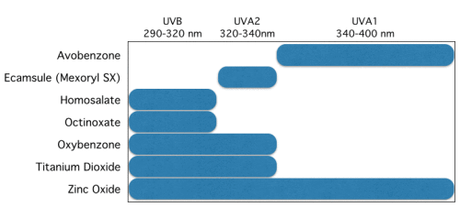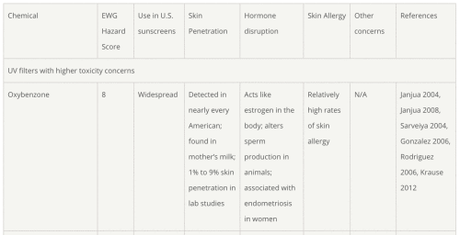Today, I listened to a story from Science Friday about sunscreen. It’s an interesting story: sunscreen use is on the rise, but so are cases of melanoma. Why? One idea, called the ‘compensation hypothesis’ is that sunscreen with high UVB but low UVA protection, stops sunburn and enables people to spend more time in the sun. This additional time in the sun, without UVA protection therefore allows the greater accumulation of cancer-causing mutations induced by the UVA light which can lead to melanoma. That’s right, just because you’re not getting a sunburn doesn’t mean you’re not damaging your skin and your skin’s DNA. And so far, so good, this all makes sense, and is important to point out.

It features an interview with senior scientist David Andrews at the Environmental Working Group (EWG), which claims that 73% of sunscreens don’t meet the EWG’s standards because they either:
- Are inefficacious products that don’t provide UVA protection or live up to their claims – The EWG’s recommendations for the US: use products with Zinc oxide or Avobenzone that provide UVA protection and SPF 30-50.
- They contained ‘concerning ingredients.’ A 2017 article from the EWG states: “the most worrisome is oxybenzone, added to nearly 65 percent of the non-mineral sunscreens in EWG’s 2017 sunscreen database. Oxybenzone can cause allergic skin reactions (Rodriguez 2006). In laboratory studies it is a weak estrogen and has potent anti-androgenic effects (Krause 2012)… In a recent evaluation of CDC-collected exposure data for American children, researchers found that adolescent boys with higher oxybenzone measurements had significantly lower total testosterone levels (Scinicariello 2016). The study did not find a similar effect in younger boys or females. ”
They summarize these and other effects in a table:

But why should we trust the EWG’s list of ‘concerning ingredients,’ over that of the FDA or American Association of Dermatology (AAD)? The EWG would probably that because Oxybenzone was already in use in the 1970s it was grandfathered in and never properly evaluated for potential hazards, and that combined with a half dozen laboratory studies suggest it should be avoided according to precautionary principles–and these would be reasonable claims. So what does the AAD say: “No data shows that oxybenzone causes hormonal problems in humans. No data shows that oxybenzone causes any significant health problems.”
If you look at it closely, the EWG and AAD aren’t factually contradicting one another, they’re just looking at the exact same information and coming to the opposite conclusions about Oxybenzone. The EWG says, “Hey! look at these laboratory studies, maybe we shouldn’t put this on humans until we’ve done human studies, and we can use these other sunscreens instead.” The AAD says, “Hey! sunscreen is good we know there are real benefits from it, and there’s no evidence it’s bad in humans, so go ahead, lather away.”
So does this all come down to how risk averse you are? Are there other hidden biases influencing the two groups positions? The EWG has a scientifically dubious stance on genetically modified foods, though their sunscreen advice seems far more consistent and reasonable, they receive funding from “private foundations, individuals, online donors and socially responsible companies that offer a wide range of products and services, including organic food, personal care products and financial services.” Are the AAD or are it’s members influenced by corporate funding or some other bias? It’s possible, according to a 1998 Mother Jones article: “dermatologists get much of their information from the Skin Cancer Foundation (SCF), and the SCF, in turn, is heavily supported by the sunscreen industry.”
But I’m not trying to use this as evidence to dismiss either side, but rather bring up a fundamental question in trying to rationally interpret the world and perform or interpret science journalism.
The world is complicated enough that we have to rely on experts, but how can we know which experts to trust?
We should look for biases: explicit ones created by funding or liability, and personal biases caused by attachment to a scientist’s own idea or subscription to an ideology. We should also look for evidence of polemics or lack of rigor: is an expert selectively citing data that only agrees with their argument, have they really done their homework or are they relying on their remembered and possibly outdated knowledge from when they trained decades ago.
In the end though we often will have to settle for a disappointing truth: the world is complicated, and most controversial issues don’t have clear answers.
And I’ve learned the disappointing but valuable truth that I should probably get some new sun screen:
One that has an SPF >=30, “wide-spectrum” protection that therefore includes UVA-protection, is and I guess doesn’t include oxybenzone? And I’ll blindly trust my medical school lecture for now that recommends a combination of mineral and non-mineral sunscreens and therefore actually goes against a lot (all?) of the EWG’s recommendations, which only feature Titanium Oxide or Zinc Oxide. (Unlike EWG, consumer reports suggests that these natural products don’t live up to their SPF ratings.)
I looked around online for a bit to find products like this, and it’s hard to find many that contain both zinc oxide and chemical absorbers. I did eventually find this water-resistant Shiseido sunscreen, and non-water resistant blue-lizard sunscreen.
To be honest, I probably won’t order these until my current sunscreen runs out. In the meanwhile, I’ll try to wear a hat, avoid the sun at peak hours, and put on sunscreen in addition when I know I’ll have a prolonged exposure like at an outdoor event.
Advertisements
